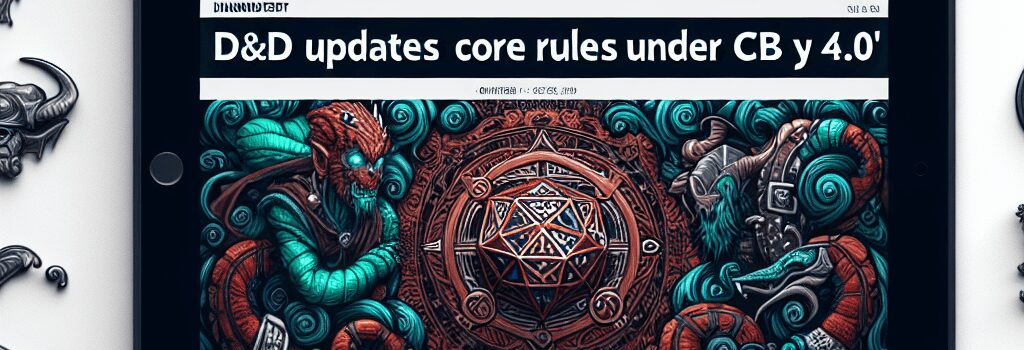D&D Updates Core Rules Under CC BY 4.0

In April 2025, Wizards of the Coast (WotC) officially published version 5.2 of the System Reference Document (SRD) under a Creative Commons Attribution 4.0 International (CC BY 4.0) license. This represents the culmination of a multi‑year legal and community campaign to secure a truly irrevocable, open license for Dungeons & Dragons’ core mechanics, classes, spells, races, and monsters—sans the most iconic IP like beholders, mind flayers, and displacer beasts. By moving from the original Open Gaming License (OGL) to CC BY 4.0, WotC has guaranteed that no future tweaks can strip developers of the freedoms they’ve come to rely on.
Background: From OGL 1.0 to CC BY 4.0
WotC first introduced the Open Gaming License in 2000, modeled after the GNU GPL, to foster third‑party creation and expand the tabletop RPG ecosystem. The OGL 1.0 allowed anyone to reprint or adapt core rules, royalty‑free. However, in January 2023, WotC leaked a draft OGL 1.1 that imposed revenue thresholds ($50,000 reporting, $750,000+ royalties at 25%), and attempted to revoke OGL 1.0—sparking industry backlash. After a year of heated debate, developer boycotts, and expert IP analysis on the revocability of perpetual licenses, WotC retreated. In November 2024, the company announced it would reissue the SRD under CC BY 4.0, an irrevocable, legally robust framework that preserves attribution while preventing unilateral license changes.
Key Additions in SRD 5.2
- Comprehensive “Rhythm of Play” and “Exploration” guidelines aligned with 2024’s D&D One rules.
- Expanded character options: five new ancestries (goliath, orc), four new backgrounds (criminal, sage, soldier, urban scavenger).
- 16 feats, including Archery Fighting Style, Great Weapon Fighting, Mobile, and specialized racial boons.
- New equipment entries (x5), 20 spells spanning cantrips to 9th‑level rituals, 15 magic items like the Cloak of the Manta.
- 17 monsters—including the hippopotamus and deeper stat blocks for hydra, owlbear variants, and raiders.
Technical Breakdown of CC BY 4.0
The CC BY 4.0 license grants four primary rights: share (copy and redistribute), adapt (remix, transform), no additional restrictions, and attribution (credit WotC and link to the license). Unlike OGL, CC BY 4.0 is explicitly irrevocable—Article 2(a)(5) prevents licensors from later stripping these permissions. Additionally, the license clarifies treatment of Machine‑readable Terms and prohibits applying “effective technological measures,” ensuring compatibility with digital distribution (PDFs, VTT modules, mobile apps) without DRM conflicts.
Expert Perspectives on Licensing Shift
Intellectual property attorney Dr. Marissa Tran (University of Michigan Law) notes: “CC BY 4.0’s global robustness outperforms the OGL in enforceability. Creators gain peace of mind, knowing that attribution is the only ongoing requirement.” Game designer Jeremy Crawford, principal rules architect at WotC, adds: “We worked closely with community volunteers to define which elements remained Open Gaming Content. The result empowers designers to build compatible adventures and settings without fear of future license revisions.”
Digital Tools and Virtual Tabletops
Roll20, Foundry VTT, and Fantasy Grounds have already integrated SRD 5.2 assets into their platforms, automating character sheets, monster AI behaviors, and encounter calculators. Software vendors appreciate that CC BY 4.0’s machine‑readable metadata schema aligns with existing JSON and XML frameworks, allowing seamless import/export of spells, feats, and token data. The license explicitly covers digital goods, removing previous ambiguity about whether virtual modules fell under the OGL’s “printed material” clause.
Next Steps for Third-Party Creators
Indie publishers and fan creators should:
- Review the CC BY 4.0 Deed and Legal Code to confirm attribution wording: “Based on Dungeons & Dragons, SRD 5.2, licensed under CC BY 4.0.”
- Avoid trademarked terms (e.g., “Eberron,” “Forgotten Realms”) and iconic monsters like beholders—these remain outside the SRD.
- Leverage SRD 5.2 in digital toolchains: import stat blocks via JSON, automate TLDRs with AI‑assisted layout engines, and publish via Print‑on‑Demand API services.
Industry Impact and Future Outlook
With CC BY 4.0 in place, we expect a surge of modular content: deck‑builder card games, AR integration projects, and AI‑driven NPC generators that draw directly from SRD datasets. Open-source communities are already forking GitHub repositories to build rule‑compliance validators, ensuring homebrew adventures adhere to licensing requirements. As the tabletop market grows—forecasted at $2.7 billion by 2028—this licensing clarity will be a key driver of innovation at the intersection of analog and digital play.